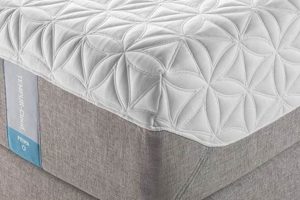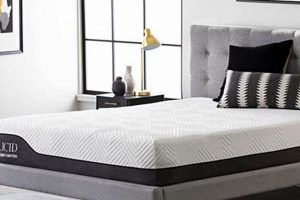A sleep system designed for spacious comfort, these offerings typically include a large-format mattress paired with a foundation or box spring to provide optimal support and elevation. These sets are designed to accommodate individuals or couples who desire ample personal sleeping space. A typical example would be a buyer choosing a firm mattress with a standard-height foundation for enhanced back support.
The importance of selecting an appropriate sleep surface and support system lies in its potential impact on sleep quality and overall well-being. Ample space reduces sleep disturbances caused by partner movement, while proper support promotes spinal alignment and minimizes pressure points. Historically, the availability of larger mattress sizes reflects increasing affluence and a greater emphasis on personal comfort within the home.
The subsequent sections will delve into the factors to consider when choosing a set, including mattress type, foundation options, and considerations for room size and budget, providing a framework for informed decision-making.
Selection Guidance
The following guidelines aim to assist in the appropriate selection of a sleep system tailored to individual needs and spatial considerations.
Tip 1: Assess Spatial Dimensions: Measure the intended bedroom area to ensure adequate clearance for the bed frame and surrounding furniture. A king-size bed requires a significantly larger room than smaller alternatives. For example, a room measuring 12 feet by 12 feet is generally considered the minimum acceptable size.
Tip 2: Evaluate Sleeping Preferences: Determine desired firmness and support levels. Back and stomach sleepers often benefit from firmer mattresses, while side sleepers may prefer a softer surface. Consider testing various options in-store to assess individual comfort.
Tip 3: Research Mattress Composition: Investigate the materials used in the mattress construction, such as memory foam, innerspring, or latex. Each material offers distinct properties related to temperature regulation, motion isolation, and durability. For example, latex mattresses are known for their resilience and breathability.
Tip 4: Consider Foundation Height: Select a foundation height that complements the overall bed height and facilitates ease of entry and exit. Low-profile foundations offer a modern aesthetic, while standard-height foundations provide additional storage space underneath the bed.
Tip 5: Examine Warranty Provisions: Carefully review the warranty terms and conditions offered by the manufacturer. A comprehensive warranty provides protection against manufacturing defects and premature wear and tear. Pay close attention to the duration of the warranty and the specific issues covered.
Tip 6: Check for Certifications: Look for certifications from reputable organizations, such as CertiPUR-US, which indicate that the mattress materials meet specific standards for emissions, content, and durability. Certifications provide assurance of product safety and quality.
Tip 7: Budgetary Considerations: Establish a realistic budget that accounts for the cost of both the mattress and the foundation. Prices can vary significantly based on brand, materials, and features. Weigh the initial investment against the long-term benefits of a high-quality sleep system.
Prioritizing these factors helps ensure a selection that aligns with individual needs, promotes restorative sleep, and maximizes long-term satisfaction.
The subsequent section will explore the specific benefits and limitations of various mattress types.
1. Dimensions and Space
The correlation between spatial dimensions and king-size bed sets is paramount. The generous dimensions of this bedding option necessitate careful consideration of room size to ensure functionality and aesthetic harmony. The subsequent points elaborate on this crucial relationship.
- Minimum Room Size Requirements
A king-size bed requires a significantly larger room compared to twin, full, or queen sizes. Cramped quarters can impede movement, hinder accessibility to other furniture, and diminish the overall ambiance. A room measuring at least 12 feet by 12 feet is generally considered the bare minimum to comfortably accommodate a king-size bed and allow for adequate circulation.
- Bed Frame Dimensions and Clearance
Beyond the mattress itself, the bed frame adds to the overall footprint. Bed frames can vary in width and length depending on their style and construction. Account must be taken for headboards, footboards, and side rails. Adequate clearance around the bed, typically at least two feet on each side, is essential for ease of access and safety.
- Impact on Other Furniture Placement
The presence of a large bed can severely limit options for arranging other furniture pieces. Nightstands, dressers, and seating areas must be strategically positioned to avoid overcrowding. In smaller rooms, it may be necessary to downsize or eliminate certain furniture items to create a more balanced and functional space.
- Visual Proportion and Aesthetics
The size of the bed should be visually proportionate to the room. A king-size bed in a small room can appear overwhelming and disrupt the aesthetic balance. Conversely, a smaller bed in a large room may seem insignificant and lacking in presence. Achieving visual harmony requires careful consideration of scale and proportion.
In summary, the relationship between dimensions and space significantly impacts both the practical functionality and the visual appeal of a bedroom featuring a king-size set. Prioritizing accurate measurements and strategic planning is essential for creating a comfortable and aesthetically pleasing environment.
2. Support and Comfort
The parameters of support and comfort are critical determinants of sleep quality when considering king size mattress sets. These elements directly influence spinal alignment, pressure point relief, and overall sleep experience. Optimizing both support and comfort is essential for restorative sleep and long-term physical well-being.
- Spinal Alignment and Posture
Proper spinal alignment is fundamental to minimizing back pain and promoting healthy posture. A mattress that provides adequate support prevents the spine from sagging or arching excessively during sleep. The level of support required varies based on individual body weight, sleeping position, and pre-existing conditions. For instance, individuals who sleep on their back typically require firmer support to maintain natural spinal curvature. King-size mattresses offer a wider surface area, allowing for greater freedom of movement without compromising spinal alignment.
- Pre
ssure Point ReliefPressure points occur when certain areas of the body, such as the shoulders, hips, and knees, bear excessive weight against the mattress surface. This can lead to discomfort, numbness, and restricted blood flow. Mattresses designed for pressure point relief utilize materials that conform to the body’s contours, distributing weight more evenly. Memory foam and latex are common materials employed for this purpose. In the context of king-size mattress sets, couples with differing weight distributions can benefit from pressure-relieving properties that cater to individual needs.
- Mattress Firmness and Feel
Mattress firmness is a subjective measure of how hard or soft a mattress feels. Firmness levels typically range from extra-soft to extra-firm, with medium-firm being the most common choice. The ideal firmness level depends on individual preferences and sleeping position. Side sleepers often prefer softer mattresses that cushion the shoulders and hips, while stomach sleepers generally require firmer support to prevent lower back strain. King-size mattress sets offer the opportunity to select a mattress with a firmness level that accommodates individual needs or compromises between partners.
- Motion Isolation
Motion isolation refers to a mattress’s ability to minimize the transfer of movement from one side of the bed to the other. This is particularly important for couples who share a bed, as it reduces sleep disturbances caused by partner movement. Memory foam and pocketed coil mattresses are known for their excellent motion isolation properties. King-size mattress sets, due to their larger surface area, inherently provide more space for each individual, further minimizing the impact of movement during sleep.
In conclusion, the interplay between support and comfort is crucial in determining the suitability of a king-size mattress set. Considering factors such as spinal alignment, pressure point relief, firmness preferences, and motion isolation enables informed selection and optimizes the potential for restful and restorative sleep. The spaciousness afforded by the king-size format further enhances the benefits of these design considerations.
3. Material Composition
The composition of materials within a king-size mattress set significantly influences its comfort, durability, and overall performance. An understanding of these components is essential for informed purchasing decisions and optimizing sleep quality.
- Foam Density and Type
Foam density, measured in pounds per cubic foot (PCF), dictates the longevity and support characteristics of a mattress. Higher density foams resist compression and provide enhanced durability. Memory foam, polyurethane foam, and latex foam are common types used in mattresses. For example, a high-density memory foam layer contours to the body, offering pressure relief and motion isolation, while a high-density polyurethane foam core provides structural support in king-size mattress sets.
- Coil Systems
Innerspring mattresses rely on coil systems for support. Different coil types, such as Bonnell coils, pocketed coils (also known as Marshall coils), and continuous coils, offer varying degrees of support and motion isolation. Pocketed coils, where each coil is individually wrapped, minimize motion transfer across the bed, a beneficial feature for couples sharing a king-size mattress. Coil gauge (thickness) also affects firmness and durability.
- Cover Fabrics
The mattress cover fabric affects breathability, temperature regulation, and surface comfort. Common materials include cotton, polyester, and rayon blends, as well as specialized performance fabrics designed for moisture wicking and cooling. For instance, a quilted cotton cover enhances breathability and creates a softer sleeping surface. The durability of the cover also impacts the overall lifespan of the king-size mattress set.
- Fire Retardant Barriers
Federal regulations mandate fire retardant barriers in mattresses to enhance safety. These barriers can consist of various materials, including treated rayon, silica, or wool. The choice of fire retardant material can affect the comfort and breathability of the mattress. Consumers may prioritize mattresses with natural fire retardant barriers, such as wool, for their hypoallergenic and temperature-regulating properties.
These material considerations collectively contribute to the overall comfort, support, and longevity of king-size mattress sets. Varying combinations of foam, coil systems, cover fabrics, and fire retardant barriers yield distinct performance characteristics, influencing the sleep experience and long-term value of the product. Evaluating these factors enables consumers to select a set that aligns with their individual needs and preferences.
4. Foundation Stability
The structural integrity of the foundation supporting a king-size mattress set is paramount for longevity, comfort, and proper weight distribution. A stable foundation mitigates premature wear, maintains mattress warranty validity, and ensures optimal sleep support.
- Weight Distribution and Support
A properly constructed foundation evenly distributes the considerable weight of a king-size mattress and its occupants. Inadequate support can lead to sagging, uneven wear, and compromised spinal alignment. For instance, a center support beam is crucial for foundations designed to support king-size mattresses, preventing bowing and ensuring uniform weight distribution across the entire surface area.
- Foundation Material and Construction
Foundation materials and construction techniques significantly influence stability and durability. Common materials include wood, metal, and composite structures. Solid wood frames with reinforced joints provide robust support, while metal foundations offer inherent strength and resistance to warping. Examples include kiln-dried hardwood frames designed for long-term structural integrity and heavy-gauge steel frames engineered to withstand significant weight loads.
- Impact on Mattress Warranty
Many mattress warranties stipulate the use of a compatible and structurally sound foundation. Using an unsuitable or damaged foundation can void the warranty, leaving the owner responsible for repair or replacement costs. For example, a warranty may require the use of a specific type of foundation or specify weight limits that must not be exceeded. Compliance with these requirements is crucial for maintaining warranty coverage of king-size mattress sets.
- Noise Reduction and Motion Isolation
A stable foundation minimizes noise and motion transfer, contributing to a more restful sleep environment. Squeaking, creaking, or vibrations caused by an unstable foundation can disrupt sleep and exacerbate existing sleep disturbances. Solid construction and secure attachment mechanisms mitigate these issues. Examples include foundations with non-slip surfaces and tightly fitted components designed to prevent noise and motion transfer during sleep.
These interconnected facets underscore the critical role of foundation stability in maximizing the benefits and lifespan of king-size mattress sets. Selecting a foundation tha
t provides adequate support, conforms to warranty requirements, and minimizes noise enhances sleep quality and protects the investment in a premium sleep system. Conversely, neglecting foundation stability can lead to premature mattress degradation, compromised comfort, and voided warranty coverage.
5. Budget and Value
The intersection of budgetary constraints and perceived value is a crucial consideration when acquiring a king-size mattress set. The expanded dimensions and enhanced material composition typically associated with these sets often translate to a higher initial investment. Determining the appropriate balance between cost and long-term benefits necessitates careful evaluation.
- Initial Cost vs. Longevity
The upfront expense of a king-size mattress set can be substantial. However, higher-quality materials and construction techniques often contribute to increased durability and a longer lifespan. A less expensive set may require replacement sooner, potentially resulting in higher long-term costs. Evaluating the expected lifespan and the materials used can inform the decision-making process. Example: A set constructed with high-density memory foam and reinforced coils may justify a higher initial price point due to its extended lifespan compared to a set with lower-density foam and thinner gauge coils.
- Features and Benefits Justification
Premium king-size mattress sets often incorporate advanced features such as enhanced motion isolation, temperature regulation, and adjustable firmness settings. These features contribute to improved sleep quality and overall comfort, potentially justifying a higher price. Assessing the individual needs and preferences of the user is essential in determining the value of these additional features. For instance, a couple with differing sleep preferences might find the enhanced motion isolation of a higher-end set to be a worthwhile investment.
- Warranty and Return Policies
The warranty and return policies offered by the manufacturer or retailer can significantly impact the perceived value of a king-size mattress set. A comprehensive warranty provides protection against manufacturing defects and premature wear, mitigating the risk of unexpected replacement costs. A generous return policy allows consumers to test the mattress in their home environment and return it if it does not meet their expectations. Examining these policies is essential for assessing the long-term value and minimizing potential financial risks.
- Financing Options and Promotions
Various financing options and promotional offers can reduce the financial burden of purchasing a king-size mattress set. Retailers often offer interest-free financing plans or discounts during specific sales periods. Evaluating these options can make a higher-quality set more accessible within a given budget. However, it is crucial to carefully review the terms and conditions of financing agreements to avoid incurring unexpected fees or interest charges.
In summary, achieving an optimal balance between budget and value in the context of king-size mattress sets requires careful consideration of the initial cost, longevity, features, warranty policies, and available financing options. Prioritizing long-term value and individual needs over the lowest possible price can result in a more satisfying and cost-effective purchase in the long run. Consideration must be given to whether features like increased space or premium materials justify the premium price point.
Frequently Asked Questions
This section addresses common inquiries and concerns pertaining to king-size mattress sets, providing factual information to aid in informed decision-making.
Question 1: What are the standard dimensions of a king-size mattress?
The standard dimensions of a king-size mattress are 76 inches in width and 80 inches in length. These dimensions may vary slightly depending on the manufacturer and specific model. Verifying the exact measurements before purchasing is advisable to ensure compatibility with existing bed frames and room size.
Question 2: What are the primary benefits of selecting a king-size mattress set?
The primary benefits include increased sleeping space, reduced motion transfer (particularly beneficial for couples), and enhanced comfort due to the ample surface area. The expansive surface allows for greater freedom of movement and reduces the likelihood of sleep disturbances caused by partner movement.
Question 3: What type of foundation is recommended for a king-size mattress?
A sturdy and supportive foundation is essential for a king-size mattress to prevent sagging and maintain warranty validity. Options include traditional box springs, platform beds, and adjustable bases. The specific recommendation depends on the type of mattress and individual preferences; however, ensuring adequate support is crucial for preserving mattress integrity.
Question 4: Does a king-size mattress require special bedding?
Yes, standard bedding sizes designed for smaller mattresses (e.g., twin, full, queen) will not fit a king-size mattress. Specifically, king-size sheets, comforters, and duvet covers are necessary. Investing in appropriately sized bedding ensures a proper fit and avoids undue stress on the seams and fabric.
Question 5: How does the weight of a king-size mattress set affect transportation and setup?
King-size mattress sets are considerably heavier than smaller sizes, potentially requiring two or more individuals for safe transportation and setup. Professional delivery and installation services are advisable, particularly for individuals with physical limitations. Ensuring adequate space and a clear path to the bedroom is essential prior to delivery.
Question 6: How can the longevity of a king-size mattress set be maximized?
Several factors contribute to maximizing the lifespan of a king-size mattress set. These include using a mattress protector, rotating the mattress regularly, ensuring proper foundation support, and avoiding excessive weight or pressure on specific areas. Adhering to manufacturer recommendations regarding care and maintenance is also critical.
Selecting a suitable king-size mattress set requires careful consideration of dimensions, support, foundation compatibility, and maintenance practices. Addressing these concerns proactively ensures a comfortable and durable sleep solution.
The following section will present a comparative analysis of common mattress types to assist in the selection process.
Conclusion
This examination has elucidated the multifaceted considerations inherent in selecting king size mattress sets. Dimensions, support mechanisms, material composition, foundation stability, and budgetary implications all warrant careful scrutiny. The relative importance of these factors varies according to individual needs and spatial constraints. A comprehensive understanding of these elements facilitates informed decision-making.
The selection of a king size mattress set constitutes a significant investment in long-term sleep quality and overall well-being. Prospective purchasers are encouraged to apply the knowledge gained herein to navigate the available options and procure a set that aligns with their specific requirements. Thoughtful consideration will yield a sleep environment conducive to restorative rest and lasting satisfaction. Further research into
specific mattress technologies and retailer offerings is encouraged.







![Best California King Adjustable Mattress [Guide] Organic & Natural Mattress Buyer’s Guide: Non-Toxic Sleep Solutions Best California King Adjustable Mattress [Guide] | Organic & Natural Mattress Buyer’s Guide: Non-Toxic Sleep Solutions](https://mattressworldpa.com/wp-content/uploads/2025/07/th-8133-300x200.jpg)